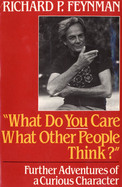
| Told To: | Ralph Leighton |
| Publisher: | Bantam |
| Copyright: | October 1988 |
| Printing: | November 1989 |
| ISBN: | 0-553-34784-5 |
| Format: | Trade paperback |
| Pages: | 248 |
What Do You Care What Other People Think? is a follow-up to the earlier Surely You're Joking, Mr. Feynman!, containing further stories told by Nobel-prize-winning physicist Richard Feynman to his friend Ralph Leighton. About half the book is taken up by a detailed history of Feynman's role in the investigation of the Challenger disaster; the rest is stories similar to the first book, some random letters, and a speech to the National Academy of Sciences.
According to Wikipedia, the first book was a surprise success and led to this sequel. I don't know how much credence to give this, but given the contents of the book it's entirely plausible. The first half feels like the rejects from Surely You're Joking. They're still interesting, but they're not as compelling or as coherent of a narrative as the earlier book. There's also a letter and drawing section that feels like padding and lacks the tight pacing of the stories.
One exception to this general decrease in quality, however, is the eponymous story, an account of Feynman's romance with his first wife up to her death from tuberculosis. It's quietly sweet and interestingly revealing. It's clear, even if not stated directly, that Feynman and his wife had a very close and unconventional relationship. She was dying from tuberculosis for almost their entire relationship, and they couldn't have much physical contact for fear of Feynman getting the disease. There are also hints that their relationship even before her illness fit Feynman's disregard for unjustified social rules (it was apparently somewhat open by mutual agreement, for instance). Despite this, they were obviously devoted to each other. Feynman doesn't get into many details, nor would that have been appropriate for the tone, but it's good to read about such a relationship presented in a positive light.
The strength of the book is the second half, the story of the Challenger investigation. It's an entertaining mix of Feynman's descriptions of his unconventional and impatient efforts to cut through bureaucracy and the details of how this sort of investigation happens. The first time I read this book, I was interested primarily in the scientific explanation for why the Challenger exploded, which this story conveys quite clearly. On this re-read, I was more interested by the obstacles and difficulties of a government investigation and the way presentation, record-keeping, and committee agreement interact with the attempt to find the truth. At first glance, this looks like a story of incompetent bureaucracy getting in Feynman's way, but Feynman shows it as more complex and trickier than that (and shows the role of the press in a surprisingly positive light).
The story also highlights the communication problems at NASA and some of the institutional brokenness that led to the accident, and has since led to other accidents. Here, Feynman covers ground also studied by Edward R. Tufte, critiquing the way scientific and engineering decisions are made and how communication works inside the organization. It's a sad account, but also an interesting example of pathologies of decision-making.
This book is neither as compelling nor as entertaining as Surely You're Joking, but if you liked the first book, it's worth looking for this one as well. It is, to a large extent, the rejects from the first book, but it shows a few more interesting angles of Feynman's life. The Challenger investigation story is food for thought about post-mortems, investigations, and how to do oversight while still letting smart people get to the truth. Recommended, but read Surely You're Joking first.
Reviewed: 2008-08-18